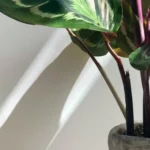Table of Contents
How to Care for Calathea Musaica
The calathea musaica is a lovely light green flowering plant native to Brazil. It is a rare plant, and it makes an attractive ornamental houseplant.
Its light green, oval-shaped leaves have an intricate network of patterning which distinguishes this choice of houseplant from others.
As an indoor plant, the calathea musaica may be difficult to care for because of its specific needs, but anyone who loves beautiful greenery often believes that the effort is worth it.
What does your calathea musaica require?
Although the calathea musaica is a difficult plant to care for, it is actually one of the easiest in the calathea family.
Light requirements
In nature, the calathea musaica grow under a canopy of other plants. As a result, the light is dappled. For houseplants, a similar form of lighting is best.
The plant still requires medium to bright light, but not directly from the sun because it can scorch the leaves.
Directionally, east or north-facing windows tend to be best. Windows facing other directions can work as well, but it is recommended that the calathea musaica be placed away from the window. A sheer curtain may help in such locations to protect from the sun.
Temperature requirements
The best temperature for the calathea musaica is between 18 and 30 degrees Celsius (65-85 degrees Fahrenheit). The foliage will stop growing in temperatures below 15 degrees Celcius (60 degrees Fahrenheit).
The calathea musaica must not be placed near radiators or drafts because they could damage the foliage.
Humidity requirements
Calathea musaica houseplants prefer high humidity levels. They can survive in moderate humidity, but dry air can cause the tips to turn brown.
To increase humidity levels, a fine mist could be sprayed into the air. A humidifier can also help. If at all possible, the humidity level should be maintained between 50-80%.
Soil requirements
Professionals recommend a well-draining, well-balanced potting mix for healthy calathea musaica plants. The soil must have both of these characteristics to prevent the plant from sitting in water, and to ensure it receives the nutrients it needs.
Soil designed for African violets, or something similar, may be used. Standard potting soil combined with perlite, gravel, or coarse sand, works well as it offers better drainage and prevents waterlogging or overwatering.
How to Water
Calathea musaica can be watered once a week. The soil should be kept moist. Soil that is too dry can cause damage to the plant. However, if the soil is getting soggy from the watering, it should be done less frequently.
Tap water is not recommended for calathea musaica. It may have too many chemicals because of the treatment it receives before being available to the public. These chemicals could damage the plant.
Filtered or distilled water is advised. If the caregiver is able to collect clean rainwater, that works nicely too.
How to Fertilize
Calathea musaica plants grow better when they are fed, but it’s vital to use a diluted form. If the fertilizer is applied in full strength, it can burn the leaves. Plant food should only be added during the growing season and not given at all during the winter.
Adding plant food to the soil every two weeks, or even each month, outside of the winter months, should suffice. Adding it less frequently, such as every six weeks, may even be enough.
Extra Tips for Calathea Musaica
Knowing the light, temperature, humidity, and soil requirements for the calathea musaica plants is essential to being able to care for them. However, there are other pieces of information that can help with ensuring the foliage is healthy for longer.
Such details pertain to dealing with common pests and diseases of the calathea musaica, plus, pruning and propagation.
Pests and Diseases
Unfortunately, there are some pests and diseases that the calathea musaica have to deal with. In most cases, when they are discovered quickly, they can be treated.
Spider mites
These are little spiders, typically black, red, or white. They often leave a dusty look on the underside of the leaves caused by the webs they weave.
Mealybugs
These small white or pink insects often mark their presence by leaving white cotton or wax-like substance where they settle. These pests are attracted to the moisture on or around the calathea musaica.
Aphids
These small creatures enjoy sucking the sap from the stems of calathea musaica. Signs of infestations include a stippling in the leaves.
Root rot
This fungal condition creates discoloration in the stem and yellowing in the leaves. It is usually caused by overwatering.
Fusarium
This fungus causes the calathea musaica leaves to turn yellow and wilt. The stem veins may turn brown.
Spider mites, mealybugs, aphids, and other types of pests that can infest the calathea musaica may be treated using natural or chemical insecticides and insecticidal soap.
It is advised to check the leaves and stems for these insects and others so that any infestations can be discovered promptly.
Root rot and fusarium, plus other fungal diseases, can usually be treated with fungicides. In most cases, the plants need repotting into a new pot with fresh soil. Any pots used must have an excellent drainage system.
Pruning
As calathea musaica plants mature, some of their outer leaves start to yellow or turn brown. To remove these. the leaves can be cut at their bases, using sharp, sterile scissors or a blade.
The cut must be made where the leaf is joined to the stalk. Pruning dead and damaged leaves from the calathea musaica not only keeps it healthier but also improves its appearance.
Propagation
Propagating calathea musaica is best done by root division in the spring before the growing season passes. When new shoots develop on the houseplant and grow slightly apart from the main plant body, this new segment can be gently pulled away.
This process requires care as the roots may be fragile. It is vital not to damage the roots during the division. Once the segments are separated, they can be potted and watered as with the mature calathea musaica.
Propagation through cuttings does not typically work with these plants.
Toxicity
Calathea musaica houseplants are non-toxic to humans and animals.
Daderot, CC0, via Wikimedia Commons
Photo by Katka Pavlickova on Unsplash


